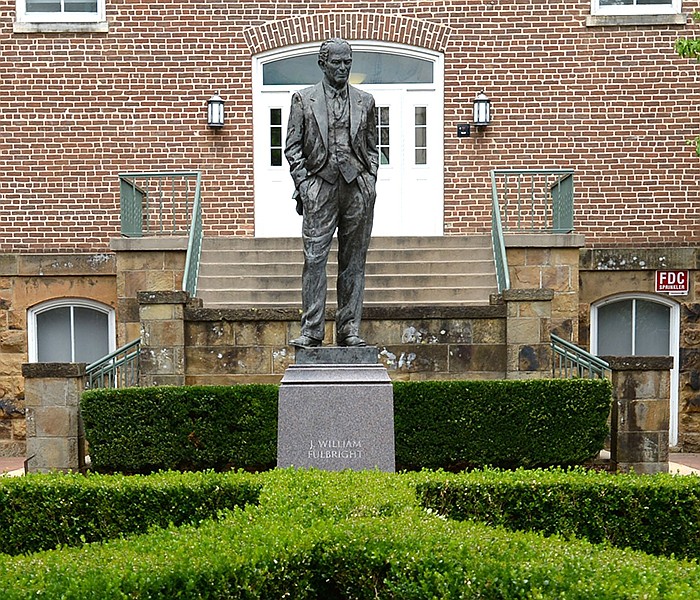A University of Arkansas, Fayetteville campus statue of former U.S. Sen. J. William Fulbright should remain in its current location but contextualized “in a way that presents the full legacy” of Fulbright, UA System President Donald Bobbitt has recommended to trustees ahead of a board meeting scheduled for Wednesday.
Fulbright is perhaps best known for introducing legislation in 1945 that created the international education exchange program named after him, but his place on the UA campus is being reconsidered given his legislative record supporting segregation and opposing civil rights in the 1950s and 1960s. He was also a UA graduate and, before becoming an elected official, served as president of the university.
Black student leaders last year called for the removal of the Fulbright statue, and a campus committee convened under former UA Chancellor Joe Steinmetz recommended in April that it be moved off campus. In a May letter to Bobbitt, Steinmetz had recommended the statue be recontextualized and remain on campus but moved from its current location outside the Old Main academic building. Steinmetz resigned last month.
Bobbitt, in his letter to trustees, cited a new state law that prohibits the removal of public monuments without a waiver from the Arkansas History Commission.
The law creates an avenue to petition for removal or relocation of a public monument, but some state lawmakers last month in a committee hearing told Bobbitt they opposed any change. Bobbitt, in his letter to trustees, described the law as prohibiting relocation of the Fulbright statue.
“If a path presents itself at a later time to consider the relocation of the statue that is consistent with state law, the Board can revisit this issue,” Bobbitt wrote.
Bobbitt also recommended that trustees approve a resolution to remove the name of former Arkansas Gov. Charles Brough from a campus dining hall.
The campus committee that reviewed Fulbright’s legacy also considered Brough and the former governor’s role in the Elaine Massacre.
Some details remain unclear about the 1919 massacre, but historians agree that an unknown number of Black residents were killed by white mobs without justification.
Both the campus committee and Steinmetz in his letter to Bobbitt had also recommended the removal of the Brough name from the dining hall.
Bobbitt’s letter to trustees also recommends that UA’s arts and sciences college keep the Fulbright name. Students and the campus committee had called for removing the Fulbright name from the college, but Steinmetz in his letter to Bobbitt had recommended keeping it.
The formal resolution to be considered by the University of Arkansas Board of Trustees states, in part, that the board “acknowledges the passage of Act 1003, which prohibits the removal or relocation of monuments on public property, and directs that the J. William Fulbright statue remain in its current location and that the University add contextualization to the statue that affirms the University’s commitment to racial equality and acknowledges Senator Fulbright’s complex legacy, including his record on international affairs, Civil Rights legislation, and racial integration.”
